Black pepper, green pepper, pink pepper, white pepper, red pepper, Szechuan pepper, lemon pepper, rainbow pepper, long pepper, Selim Kili pepper, will someone please explain the differences to me?
Black pepper is the most popular spice in the world. Your grocery probably stocks whole black peppercorns and ground black pepper as well as white pepper (whole and ground), pink peppercorns, and possibly green or red peppercorns. Then there are spices that have a similar taste but come from different plants but are still called pepper like Szechuan peppercorns. Let’s make some sense of this. (If you are looking for info about chile pepers, click here).
Like most spices, their flavors come from delicate oils and other compounds that evaporate and oxidize rapidly when the peppercorn is broken open. Their flavors can also be damaged by light. So it is best to store pepper in whole peppercorn form like a peppermill, and grind them fresh when needed. Grocery stores are loaded with ground peppers, but using them is a shortcut and a sacrifice in quality.
Black peppercorns
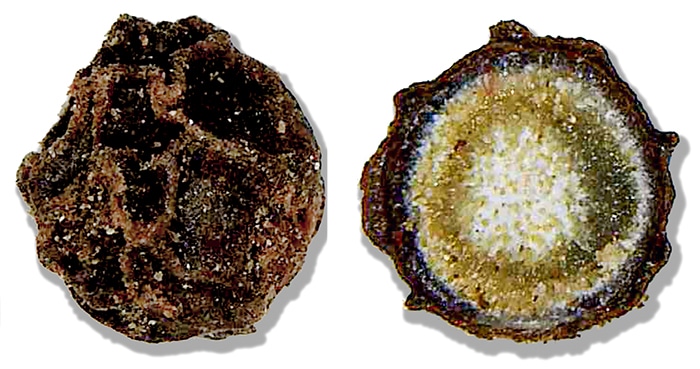
Believe it or not, black pepper is a fruit. It is grown on the Piper nigrum vine in tropical climates and Vietnam is the largest producer although Tellicherry from India and Lampong from Indonesia are considered the best. Size matters, as larger peppercorns contain more aromatic compounds, making Tellicherry peppercorns taste more complex and not just “peppery.” Tellicherry also refers to the city of Tellicherry (Thalassery), a commercial hub of the international spice trade.
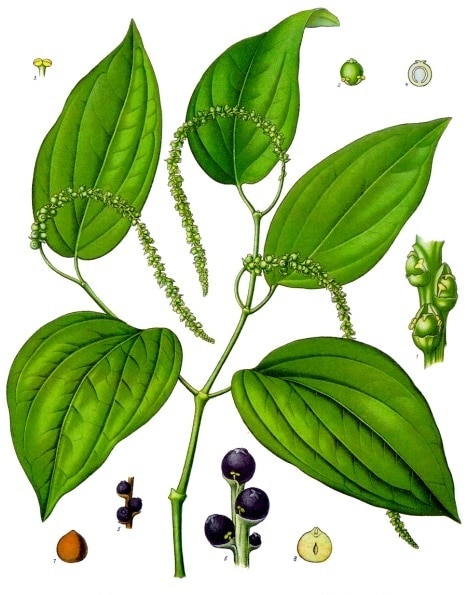
The peppercorns, technically berries called drupes, grow on a long stem, like a long skinny bunch of grapes. Black peppers are picked when green and then dried so the husks turn dark brown or black. Under the skin the seed is mostly white. Peppercorns contain a chemical called pepperine that irritates tissues in the mouth and nose, triggering a pain reaction that we experience as a sensation of burning in the mouth and causing us to sneeze. In chile peppers, which are a completely different family of fruits, the heat-producing compound is capsaicin. Black peppercorns get their citrusy, pine-like, and woody aromas from various other flavor compounds, including limonene, pinene, caryophyllene, and sabinene. These flavors are so popular and so agreeable with so many foods that black pepper goes with just about everything—even ice cream!
The size of the grind is also a quality factor. For this reason we recommend pepper mills with adjustable grinds like this one.
Whole peppercorns. Often used in marinades and brines.
Cracked. Corns that are barely crushed and pieces may be as large as halves. Used in dishes like steak au poivre where they provide exciting, crunchy, aggressive pops of flavor and spice.
Coarse grind. Large chunks, perhaps 1/8 the size of the peppercorn, they too provide distinctive texture and pops of flavor.
Shaker or table grind. A finer grit that will fit through the holes of a pepper shaker and usually served at table.
Fine grind. Almost a powder. Useful in spice rubs and blends.
Green peppercorns
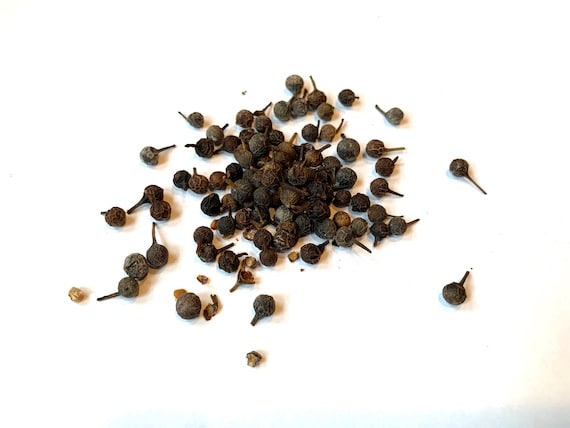
Some berries are picked when green and treated to retain their green color. They are sometimes sold in brine and confused with capers, but they are very different. They have a short shelf-life. They are very fragrant, have a milder, brighter, more floral character and work well on white meats with herbs. They can be ground and even crushed with your fingers. They can even be rehydrated by soaking in water, wine, or stock for about an hour.
Red peppercorns
When growing, as the berries ripen they turn red. Some red berries are treated to retain their color and sold as red peppercorns.
White peppercorns
If riper yellowish or red peppercorns are dried and the skin removed, what remains is a white seed. Ground white pepper is often used in recipes where black specks might be unsightly such as white sauces, cream soups, mashed potatoes, and fish dishes.
Pink peppercorns
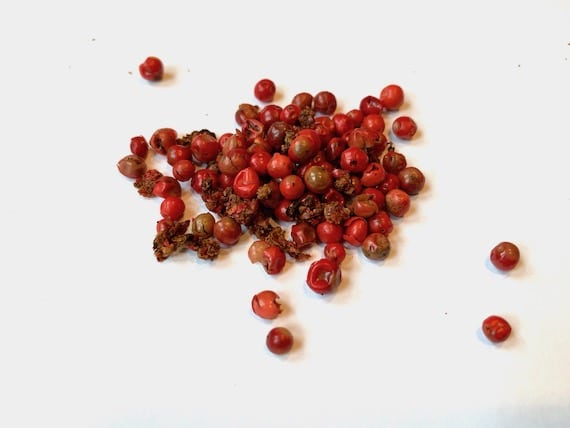
This colorful spice is from a different family than black, white, or green peppercorns. It is a members= of the cashew family. That makes it a tree nut and as such can be hazardous to people with treenut allergies. They add bright color, a spicy, sweet, citrus character, and a tingly sensation to foods. They are especially good with fruits and some sauces and they are frequently used to season Mediterranean fish recipes. Their bright, pine-like taste works wonders on game meats as well. Their outer husks tend to clog up peppermills, so it’s best to grind pink peppercorns in a mortar and pestle or an electric spice grinder if you need a lot.
Szechuan peppercorns
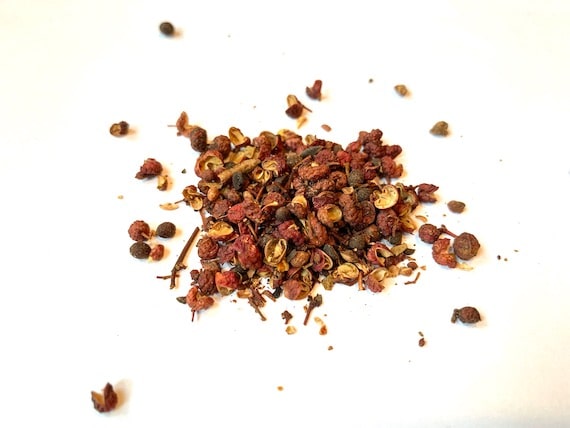
From China, Szechuan pappercorns (above) are the pod of completely different fruit from the prickly ash tree. They have a distinctive potent, prickly, piney, grapefruit, lip and tongue buzzing character, from a compound called sanshool. They can carry a bacterium that can harm citrus trees, so they were banned from the US from 1968 to 2005, and now they must be pasteurized by heating to 160°F before importing. They aren’t suited for use in a peppermill, and if they are not used whole, can be ground in a mortar and pestle. They are often used in Chinese stir-fries and are really fun on fruits. Sichuan pepper is a common addition to Chinese five-spice powder and the Japanese spice blend called shichimi togarashi. It works wonders with rich and fatty pork and duck dishes. Try adding it along with the other spices in your favorite pork rub. The flavors really come alive if you warm them in a dry frying pan (called blooming) for a minute or two before grinding, being careful to not let them smoke.
Tasmanian Pepper
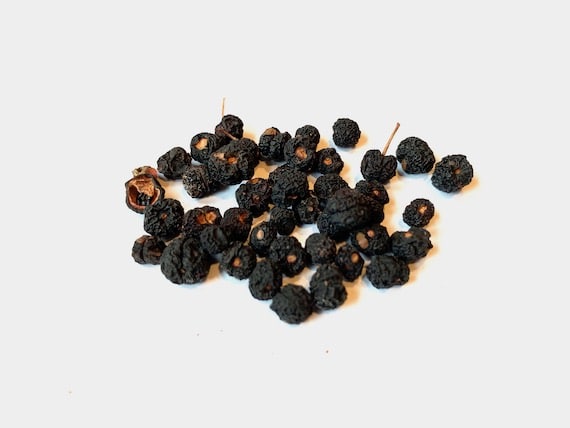
Also known as mountain pepper. The plump, purple-black dried berries of this native Australian bush are soft enough to split by hand, releasing complex hibiscus and cardamom aromas. The pleasant, lingering pungency on the tongue is attributed to a flavor compound known as polygodial. A related pepper, Dorrigo pepper, contains the same compound but tastes less complex. Tasmanian pepper became associated with Cornish cuisine after its cultivation in Cornwall, England.
Cubeb
Also known as Java pepper and tailed pepper. Native to Indonesia, these dried grey-black berries (piper cubeba) are slightly longer than true black peppercorns (piper nigrum) and retain a “tail,” which is the stem of the berries. When crushed, cubeb emits aromas of camphor, mint, and allspice and tastes pleasantly hot on the tongue. In the first century, during the T’ang dynasty, Chinese doctors used cubeb to restore appetite and rid the body of “devil vapors,” according to Edward H. Schafer in his book The Golden Peaches of Samarkand: A Study of T’ang Exotics. Cubeb pepper is used to season many Moroccan pastries, West African stews, and Indonesian curries.
Grains of Paradise
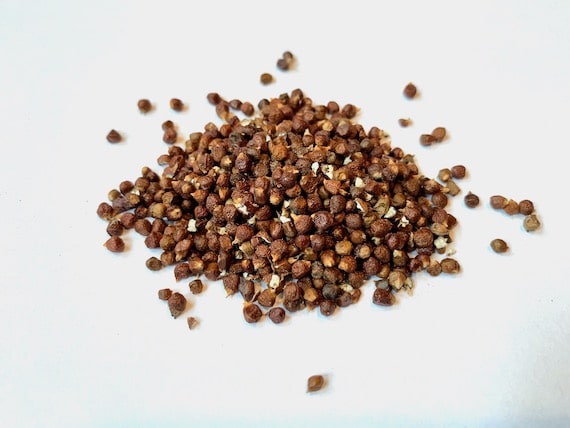
Also known as alligator pepper, Guinea pepper (or grains), and melegueta pepper. These are the pungent, aromatic seeds of a West African reed-like herb. Still used widely in Africa, the seeds were popular in Europe during the Middle Ages. They often show up in Tunisian stews.
Long Pepper
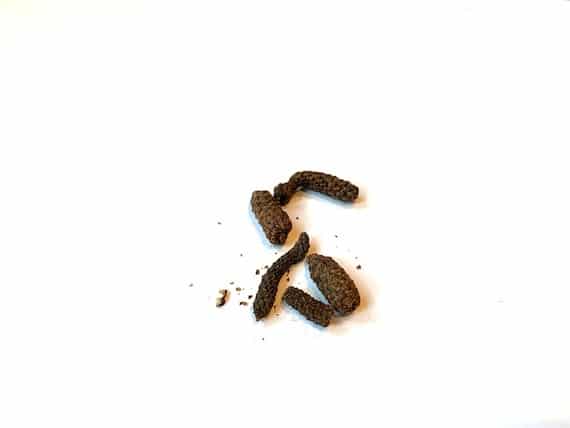
Also known as Indian, Indonesian and Java Long Pepper, and Pippali. Resembling tiny, elongated grey-black pine cones, long pepper (piper longum) is closely related to black pepper (piper nigrum) but with more citrus aromas and simple searing heat. The aromas of long pepper complement a variety of dishes in Southeast Asian cooking and are often added to Indian pickles.
Selim Kili Pepper
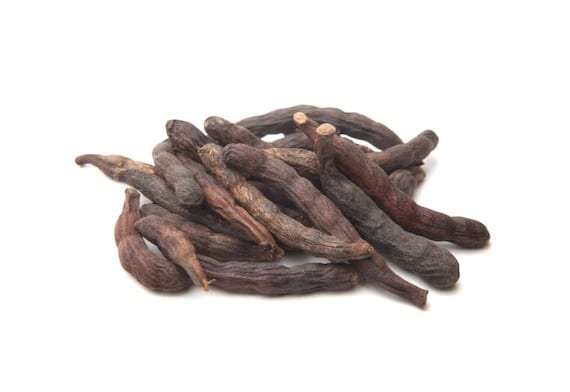
Also known as African pepper, Ethiopian pepper, grains of selim, Guinea pepper and kimba pepper. These are the slender, elongated dried pods of an African bush with aromas of eucalyptus and nutmeg in the seedpods and slightly bitter heat in the seeds. Selim kili pepper is frequently used in Nigerian stews such as goat stew.
Blends
Rainbow peppercorns. A blend of peppercorns that produces a complex range of flavors.
Lemon pepper. Made from grinding together lemon zest with black pepper, it is easy to make at home. Want a thrill? Make some limoncello and make limoncello pepper with the zest after you are done infusing the alcohol.

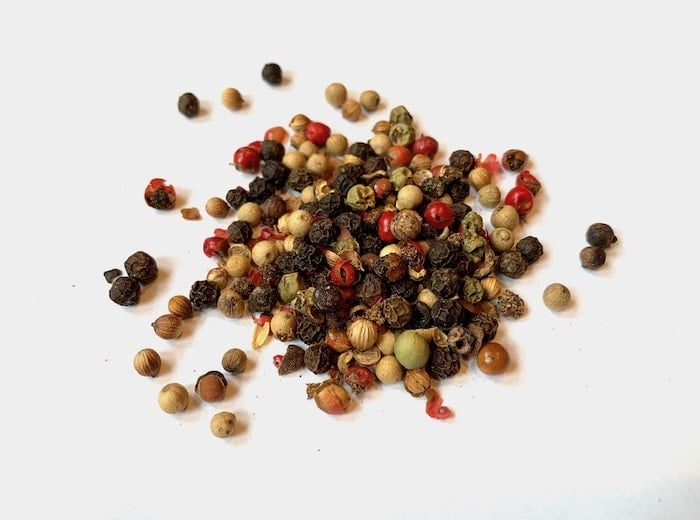

High quality websites are expensive to run. If you help us, we’ll pay you back bigtime with an ad-free experience and a lot of freebies!
Millions come to AmazingRibs.com every month for high quality tested recipes, tips on technique, science, mythbusting, product reviews, and inspiration. But it is expensive to run a website with more than 2,000 pages and we don’t have a big corporate partner to subsidize us.
Our most important source of sustenance is people who join our Pitmaster Club. But please don’t think of it as a donation. Members get MANY great benefits. We block all third-party ads, we give members free ebooks, magazines, interviews, webinars, more recipes, a monthly sweepstakes with prizes worth up to $2,000, discounts on products, and best of all a community of like-minded cooks free of flame wars. Click below to see all the benefits, take a free 30 day trial, and help keep this site alive.
Post comments and questions below
1) Please try the search box at the top of every page before you ask for help.
2) Try to post your question to the appropriate page.
3) Tell us everything we need to know to help such as the type of cooker and thermometer. Dial thermometers are often off by as much as 50°F so if you are not using a good digital thermometer we probably can’t help you with time and temp questions. Please read this article about thermometers.
4) If you are a member of the Pitmaster Club, your comments login is probably different.
5) Posts with links in them may not appear immediately.
Moderators